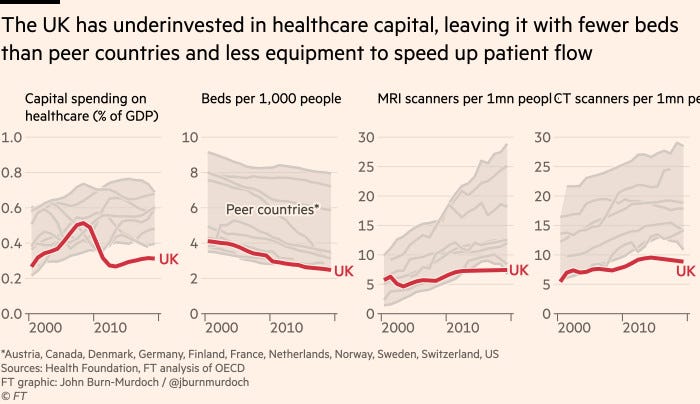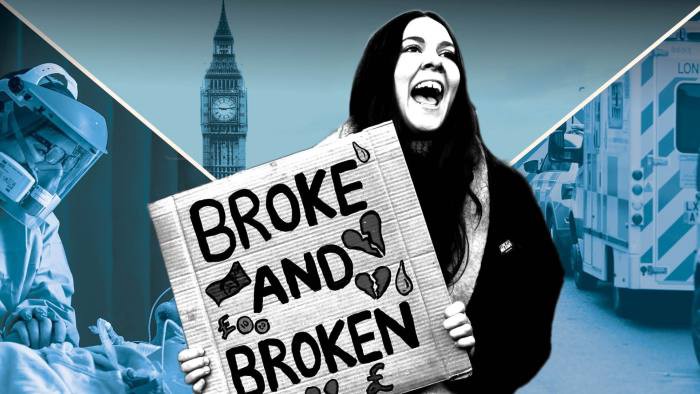health transformation
strategy institute
Joaquim Cardoso MSc
Chief Researcher, Editor & Senior Advisor
January 4, 2023
Executive Summary
- The NHS in the UK is currently facing what has been described as the worst crisis in its history due to multiple factors, including a fifth wave of Covid-19 infections and a surge in influenza, as well as a depleted and demoralized workforce.
- The Royal College of Emergency Medicine estimates that 300 to 500 people a week are dying as a result of delays to emergency care — a figure challenged by NHS England but endorsed on Tuesday by Sir David Spiegelhalter of Cambridge university, one of the country’s leading health statisticians. “It is quite plausible that hundreds of deaths a week are associated with delays to admission,” he said.
The key issues that are contributing to the current crisis in the NHS in England include:
- 1.Multiple waves of winter infections, including a surge in influenza and the fifth wave of Covid-19 infections driven by the Omicron variant. The combination of these infections is causing increased demand for hospital beds.
- 2.A shortage of hospital beds, with the UK having the lowest number of hospital beds per head of population in Europe after Sweden.
- 3.Delays in discharging patients from hospitals, with around 12,000 to 13,000 patients being medically ready to leave hospital but unable to do so because there is nowhere else for them to go.
- 4.A depleted and demoralised workforce, with staffing challenges in both the NHS and social care sectors.
- 5.Insufficient funding for social care, leading to a lack of adequate staffing and difficulties in attracting staff on the right salaries. This is also limiting the number of patients that can be transferred from hospitals into more targeted care.
- 6.A lack of coordination between different parts of the healthcare system, including between the NHS and social care.
Infographic



ORIGINAL PUBLICATION
The detailment below is an excerpt from “Why is the NHS in its worst ever crisis?”, published by the Financial Times, on January 3rd, 2023.
1.Multiple waves of winter infections
The fifth wave of Covid-19 infections since the appearance of the Omicron variant late in 2021 is washing across the UK. At the same time influenza is surging, driven by increased social mixing as distancing precautions taken during the pandemic are relaxed. The combination led England’s top doctor to warn last week that the country was in the grip of a “twindemic”.
“There are around 100,000 general and acute beds within hospitals across England,” said Stuart Hoddinott, a researcher at the Institute for Government think-tank. “According to data up until Christmas Day about 7 per cent of those are filled with individuals who are being treated for either flu or Covid.”
Other infections, such as respiratory syncytial virus and norovirus, are also circulating at higher levels than in a normal winter, partly because reduced exposure over the past three years has given people lower immunity than usual.
Although compulsory anti-Covid measures are long gone, health leaders are urging people to help limit infections by retaining some behaviour learned during the pandemic.
“If your child is unwell and has a fever, they should stay home from school or nursery until they feel better and the fever has resolved,” said Susan Hopkins, chief medical adviser at UK Health Security Agency. “Adults should also try to stay home when unwell and if you do have to go out, wear a face covering.

2.Too few hospital beds
Adrian Boyle, president of the Royal College of Emergency Medicine, said that if he had to point to a single cause of the NHS crisis, “it is that we do not have enough beds in our hospitals”.
OECD figures show the UK has the lowest number of hospital beds per head of population in Europe after Sweden, and just one-third the number of Germany.
Although building up hospital capacity requires long-term investment, the UK could make much better use of its existing beds by discharging patients more quickly into the community. According to Boyle, 12,000 to 13,000 patients, representing 10 to 12 per cent of NHS bed space, are medically ready to leave hospital but have to remain there because there is nowhere else for them to go.

He added that the quickest way to boost hospital capacity would be to train more people in social care. “That would have a faster impact than recruiting doctors and nurses for A&E departments, though we certainly need them too,” he said.
“Staffing remains one of the biggest challenges in the [social care] sector and it has a knock-on effect within the NHS,” agreed Mike Padgham of the Independent Care Group sector body.
“At the moment there are around 165,000 vacancies within the sector. Lack of adequate local funding means that homes struggle to attract staff on the right salaries, lack of staff means that a home is limited in the number of patients it can support even when there is physical capacity. Vulnerable patients are unable to be transferred from hospitals into more targeted care.”

3.Inadequate staffing
All parts of the NHS workforce, from doctors and nurses to ambulance and ancillary workers, are suffering from staff shortages that have been exacerbated by Brexit, which has made it harder to attract and keep staff from the EU.
Although the government points out that there are now 34,100 more doctors and 44,800 more nurses working in the NHS than in 2010, health leaders say this has not been sufficient to care for the growing number of patients in an increasingly sick and elderly population.
Staff exhaustion and demoralisation are making matters worse but NHS unions point to poor pay as a fundamental problem. Nurses and ambulance drivers staged strikes to demand more pay and better conditions in December and are poised to walk out again this month.
“The government must immediately address the issues with recruitment and retention of staff by paying health and social care staff a fair wage for the work they do, reversing over a decade of successive real-terms pay cuts and by fixing the ludicrous pension rules that are driving our most experienced staff to reduce their hours or leave the NHS completely,” said Vishal Sharma, chair of the British Medical Association consultants committee.
He added: “although this won’t tackle the increased demand, it will encourage those staff who want to stay in the NHS to continue working and provide some stability to the workforce whilst aiding recruitment of additional staff to fill the record numbers of vacancies.”

4.Long-term underfunding
At the heart of the NHS’s problems is that growth in demand for healthcare has exceeded increases in government funding since the 2008 financial crisis.
A report by the Health Foundation think-tank in October 2021 found that NHS funding over the coming decade would need to grow at twice the historic rate of the 2010s to meet expected demand. This would require at least 3.2 per cent annual funding increases in real terms, increasing spending by £70bn by 2030/31.

“The underlying causes of the pressures facing the NHS aren’t new and are a result of political choices,” said Hugh Alderwick, director of policy at the Health Foundation.
“They include a decade of under-investment in the NHS and wider public services, staff shortages in health and social care, weak capital investment, longstanding neglect of adult social care services, and more. These problems interact and have a cumulative effect on the system and its ability to operate.”
Names mentioned
Sir David Spiegelhalter, Stuart Hoddinott, Susan Hopkins, Adrian Boyle, Mike Padgham,












